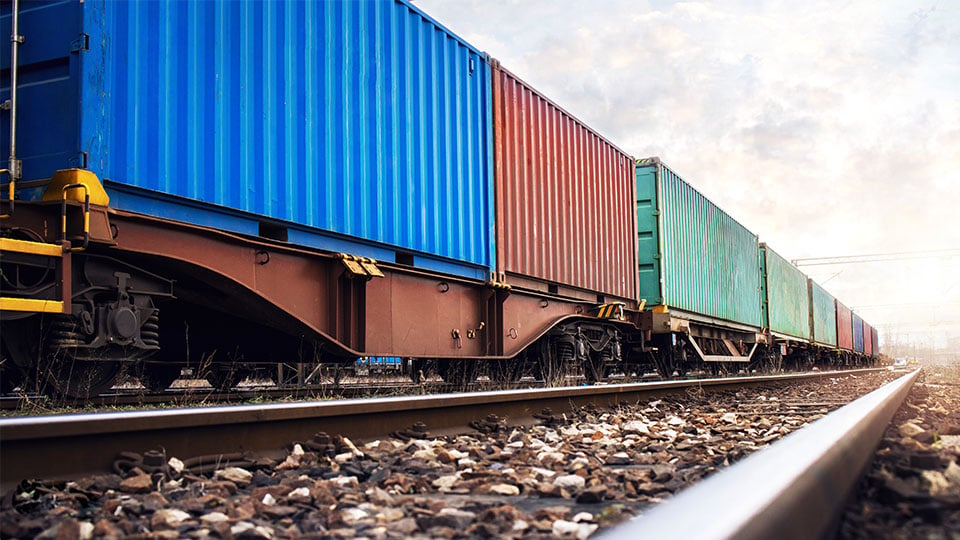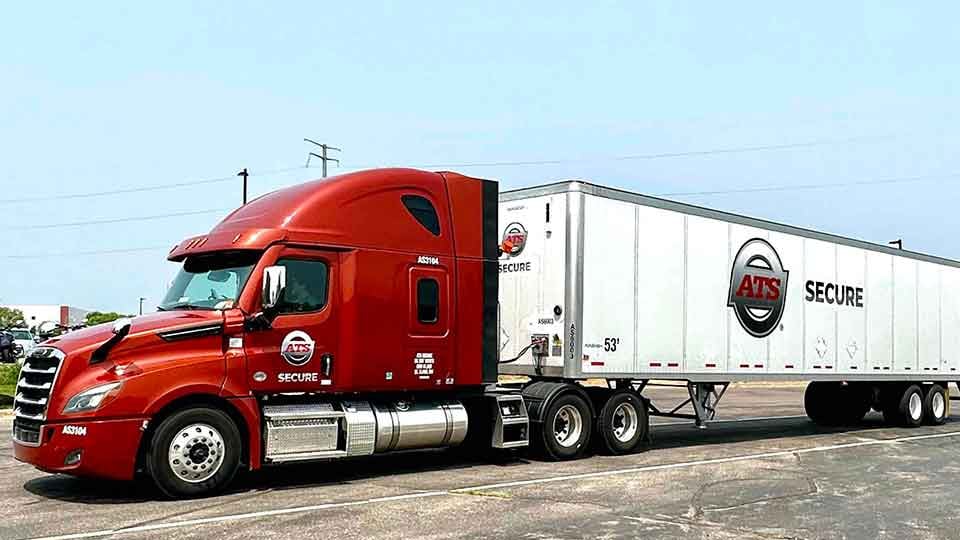
Dry vans and railcars are both options for shipping freight a long distance. Both are common sights on the road, and both are suitable for freight traveling across several states or across the country. If you need to ship a large amount of freight, it can be challenging to choose the best option. How do you determine which is the best option for you?
Here at Anderson Trucking Service (ATS), our business is moving freight … and over the course of more than 67 years, we’ve had a lot of time to compare different methods to accomplish that. Our experience has taught us the pros and cons of each method of transportation.
If you need to move freight a considerable distance, this post will arm you with the information you need to make an educated decision about whether dry van or rail shipping is better for you.
What Are the Pros of Shipping Via Train?
First up is railcar — those enclosed rectangular train cars you frequently see moving down the tracks. What are the advantages of shipping freight in a railcar?
1. Lower Cost
Compared to enclosed truck shipping, rail shipping typically costs much less. For example, when traveling from San Francisco, California, to Buffalo, New York (or another cross-country move), a railcar can cost about half as much as a dry van trailer. Railcars split the cost of each trip between a huge number of customers, creating a more cost-effective solution for those with a longer lead time.
2. Massive Weight and Volume Capacity
Another advantage of railcars is that they can carry a massive amount in one load. Multiple cars can be linked to create almost unlimited capacity. If you have a large amount of freight to be moved to the same destination at one time, that may be one reason to choose to ship via rail.
What Are the Cons of Shipping Via Railroad?
Of course, lower cost and higher capacity aren’t the only factors to consider when planning to ship freight cross country. Understanding the disadvantages of shipping via rail is also necessary to make the best decision.
1. Time
The primary reason to choose a dry van over a railcar is that the van shipment is almost always much faster.
In our example above, shipment from San Francisco to Buffalo, a dry van can make the trip in less than a week. A railcar will take three to four weeks to travel the same distance. If you need freight to arrive on a specific date, a dry van shipment is a more time-effective option.
The additional time will exponentially increase the farther the distance. A truck can reliably travel about 500 miles a day. A railcar has many more variables impacting the distance it can travel, making it much less predictable.
2. Final Mile Delivery
When shipping via railcar, the train moves only from one railyard to another. Getting your freight from the pick-up point to your final destination requires another mode of transportation (often a dry van). This may still save you money in the end, but it does require more work to ensure your freight ends up exactly where you need it.
3. Inflexibility
Railcars run on a pre-set schedule, leaving little room for flexibility. You do not have control over the route or distance traveled per day. As such, using a railcar requires additional planning time even before the freight leaves your possession.
When making a mental comparison between a dry van and a railcar, it may be helpful to think of a railcar as a public bus. A bus ride may cost a fraction of the price of a private car. In exchange, you walk to and from a bus stop and wait through multiple stops until you arrive at your destination. There will be other passengers on the bus, which will not deviate from its planned route. This is similar to a railcar, which is essentially a transport shared by multiple customers. Dry van shipping is comparable to a private car, with similar increases in cost and convenience.
What Are the Pros of Shipping Via Dry Van?
The number of dry vans you see on the road is a testament to the effectiveness of this method of shipping. There are several advantages to this mode of transportation, which include:
1. Faster Transport
Dry vans travel on a much faster and more predictable schedule than railcars. With a truckload of product, you can specify when your freight needs to be picked up and delivered — a freedom railcars just can’t promise. This can be especially advantageous when dealing with tight timelines or limited hours at the pick-up or drop-off site.
2. Easier Scheduling
With predictable routes and eager drivers, it can be no problem for a large logistics company to arrange a driver and a van within a short timeframe. You may even be able to schedule a truck for the next day. This is especially useful when freight needs to arrive immediately or within a small window of time.
3. Ability to Handle Diverse Products
Compared to railcars, dry vans are better suited for different kinds of freight. Only dry vans can be floor loaded (loaded into the truck without using pallets). The only limit to the capacity of a dry van is the size of the trailer and legal axle weight limits.
4. More Personalized Service
Dry vans usually have only one (or a few in partial or LTL scenarios) customer(s) per load. This means your freight is the driver’s only consideration. This gives you much more flexibility for pick-up and drop-off time, as well as routing and other considerations.
With a dry van shipment, you are in charge. With a railcar, the railroad company has the ultimate authority. Of course, that convenience has disadvantages as well.
What Are the Cons of Dry Van Freight Shipping?
Like anything else, dry van shipping isn’t perfect. Some of the potential pitfalls include:
1. Higher Costs
A dry van will cost more to run along your route than a load of freight moved by rail. Every truck has a driver bound by government-mandated Hours of Service requirements, leading to increased labor costs. You’re also responsible for paying for the fuel used to haul your shipment (commonly called a fuel surcharge).
This is only scratching the surface, there are a lot of other factors impacting dry van rates which (in a dedicated scenario) are higher than rail shipping rates, where costs are almost always distributed between multiple parties.
2. Greater Chances of Damage or Theft
While rare, the odds of your shipment being damaged or stolen during transit are higher when shipping via dry van than by rail. Freight insurance and basic safety measures can also help mitigate this danger. That said, it’s still present.
3. Potential For Delay
Dry van shipment is much more dynamic than shipping via rail, opening up a possibility for unplanned delays. Using a logistics provider with access to alternate vans and drivers is one way to prepare for this possibility.
In our bus analogy from earlier, dry van shipping is comparable to taking a cab or a car service. You order a vehicle to pick you up at a precise location and drop you off exactly where you need to go. There are no other passengers, and you may even be able to choose the music in the vehicle or if you want to talk to the driver. This is comparable to the service provided by an individual dry van, where you can specify the pick-up and drop-off points and dictate how your freight travels.
Shipping Via Dry Van vs Rail – Which Is Best for You?
As with most considerations in transportation and logistics, there’s no 100 percent correct answer when choosing to ship via a dry van or a railcar. But by comparing the relative factors of time, cost, flexibility and ease, you will be able to arrive at an educated decision that will help your business save on the bottom line in the long- and short-term.
When planning a shipment, the 2023 Freight Shipping Calendar can help you schedule and plan ahead. Download it today.




